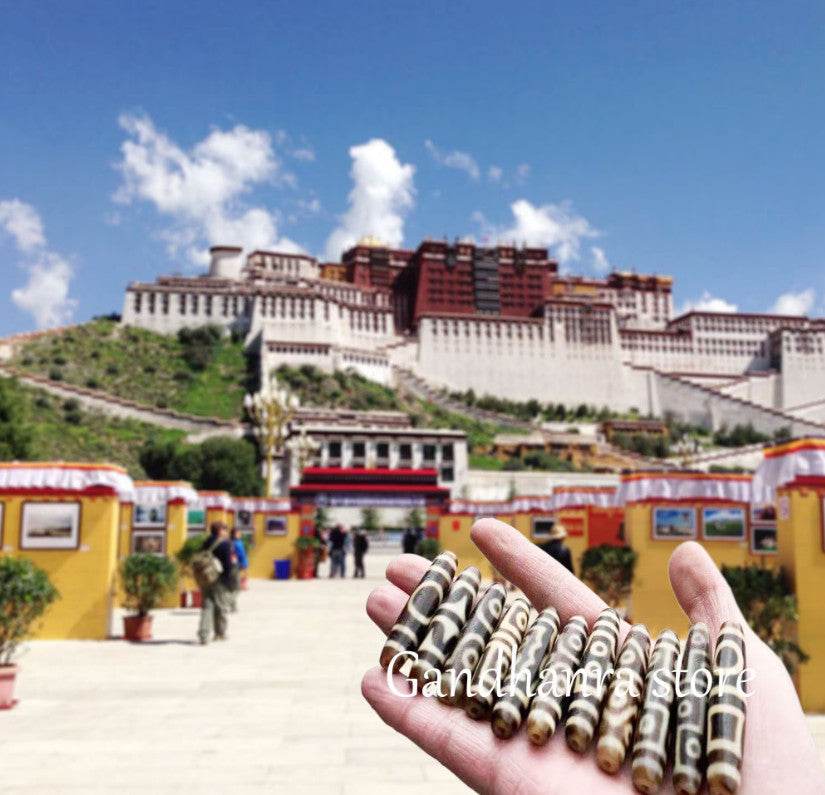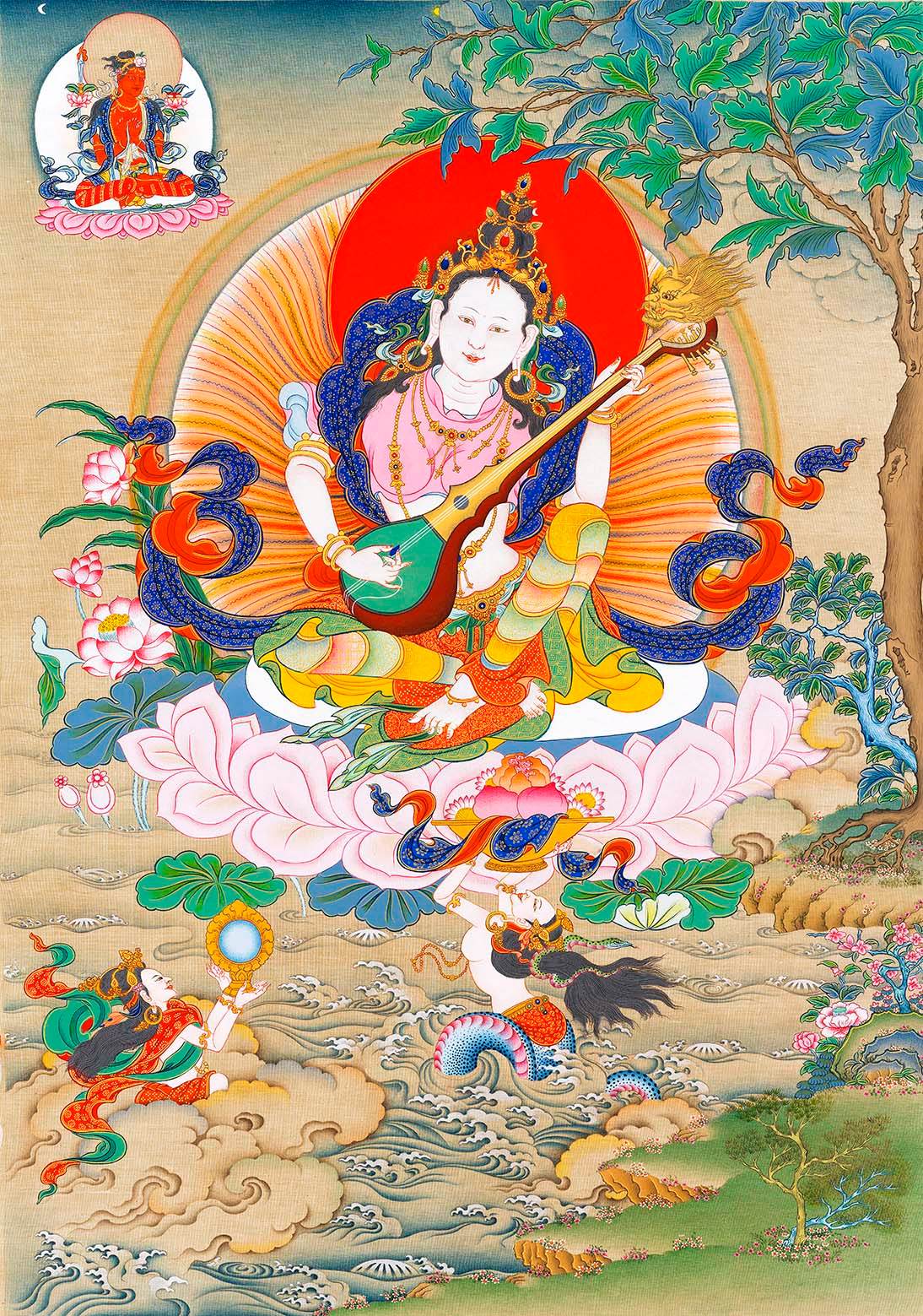
Mount Kailash flows from his pen ▎Sonam Banjo

"Mount Kailash," by Sonam Banjo. The visual composition centers on the Mount Kailash Range as both the visual and spiritual core, with four rivers extending like veins. It seeks to echo this verse of praise: "The outer snow mountain is a crystal stupa; the inner lake is an emerald mirror. The mountain of the father deity's lineage is the root of sacred sites, the source of holy springs, and the origin of treasure troves.(ཕྱི་གངས་རི་ནི་ཤེལ་གྱི་མཆོད་རྟེན། ནང་མཚོ་མོ་ནི་གཡུ་ཡི་མེ་ལོང་། ཕ་ལྷ་རབས་རྒྱུད་གྱི་གངས་རི། རྩ་ཆེན་གནས་གྱི་འབྱུང་ཁུངས། བདུད་རྩི་ཆུ་ཡི་བབས་ཁུངས། རིན་ཆེན་གཏེར་གྱི་འབྱུང་ཁུངས།)"

"The Maquan River," Sonam Banjo
In the land of Ngari, Tibet, known as "the roof of the world's roof," the sky is as clear as washed blue, snow-capped mountains stretch endlessly, and grasslands spread vast and boundless. Here is not only the origin of all mountains and the source of all rivers but also the starting point of a painter's soul and the home of his spirit. Sonam Banjo, who grew up in the pastoral areas of Ngari and now paints with both brush and chalk while teaching, shows us through his experience: some lands, once they enter your heart, become a lifelong source of creation.

"Gangsar" (གངས་བཙག), Sonam Banjo
"You stand on the Ngari grassland, watching clouds rise from behind the mountains..."
Sonam Banjo spent his childhood in the pastoral areas of Ngari. There were no art studios, no paints, yet it offered the richest classroom for art: the Tibetan robes sewn by his father’s hands, the Mani stones carved with scriptures, the yaks and sheep roaming the grasslands, the distant majestic Mount Kailash... These were his earliest "art textbooks."
"My father was very skillful. He could sew clothes, embroider patterns, and also carve Mani stones. When I was little, I often stayed by his side, watching him slowly turn an ordinary stone into a living object," Sonam Banjo recalls. Those silent moments of companionship and imitation became the earliest inspiration for his artistic perception.

Sonam Banjo's childhood with his family
His experience of herding allowed him to build an almost instinctive connection with nature. "You stand on the grassland, watching clouds rise from behind the mountains, seeing rivers shimmer under the sunlight, observing cattle and sheep running in the wind... That kind of beauty isn't taught—it's something you feel yourself," he said. "It’s a hazy, yet profoundly real, sense of beauty."
It was these seemingly ordinary everyday moments that planted the seeds of imagery in his heart. He never deliberately "decided" to become a painter, yet almost unconsciously, he picked up a brush and began transferring those vivid scenes from his mind onto paper.

Stringing sheep heads
The Birth of a Motif: Mount Kailash and the Four Sacred Springs
If Ngari is the soil of Sonam Banjo's art, then Mount Kailash and the four rivers originating from its foothills—the Sengge Tsangpo, Langchen Tsangpo, Macha Tsangpo, and Yarlung Tsangpo—are the most important "motifs" in his creations.
All this stems from his childhood memory of the "Wedding Song" echoing at weddings. "Adults sang, and children followed along, the lyrics repeatedly praising where these four rivers come from, where they go, and what civilizations they nurtured." Those melodies and words, like cultural genes, were deeply embedded in his bloodline.

Sonam Banjo, free during his childhood herding days
For example, that ancient "Wedding Song" sings:
"Wedding Song"
O river flowing north, where do you come from?
O river flowing north, where do you go?
O river flowing north, you come from the Lion's Mouth,
O river flowing north, you flow to Ladakh.
The great courage of the Ladakh people springs from you.

"Wedding Song" by Sonam Banjo
Furthermore, the knowledge passed down through his family laid a foundational understanding for him. His late maternal uncle—the renowned Tibetan scholar Guge·Tsenjen Jiebu—systematically documented and elaborated on these four rivers and their cultural significance in his academic work *The History of Ngari Civilization*. The folk songs and scholarly texts together constructed a multidimensional and profound cognitive framework for him, allowing him to deeply understand that these rivers are not merely natural waters but also flows of civilization:
The Yarlung Tsangpo River, originating from the Mapcha Yumco Lake, is regarded as the "mother river" of Tibetan culture, symbolizing origin and nourishment;
The Langchen Tsangpo River, an important cradle of the Guge civilization, served as a crossroads for multicultural exchange in history. The numerous ruins scattered along its banks silently bear witness to Ngari's once-glorious civilization;
The Sengge Tsangpo River holds a particularly intimate significance for him, as his hometown lies along its banks. This river basin, with its vast grasslands and abundant wildlife, seems to naturally nurture a spirit of bravery and openness;
The Macha Tsangpo River originates in Purang. Among the people of Ngari, it is often said that Purang is home to many beauties, a trait attributed to the nourishment of the Macha Tsangpo—a river that bestows grace and elegance.

"Sengge Tsangpo" by Sonam Banjo
Setting aside brilliant pigments, using soil and rivers to paint.
Sonam Banjo's creative journey is a practice of constantly breaking through his own boundaries. In his early years, he primarily used heavy colors on canvas, depicting the four rivers as separate subjects of his paintings, interpreting their spiritual essence through color and composition. He employed the four colors—white, red, yellow, and blue—to correspond to the four elements of water, fire, earth, and wind. His compositions were guided by the flow of the rivers, connecting the cultural heritage along their banks.

"Langchen Tsangpo" by Sonam Banjo
Upon entering his postgraduate studies, encouraged by Professors Pema Chodak and Tsewang Tashi, he began experimenting with contemporary art forms such as installation, photography, and performance. His *Four Great Rivers Gangsar Series* is particularly unique—"Gangsar" (གངས་བཙག) is a red ochre stone from the foothills of Mount Kailash, which he ground into powder and mixed with water collected from the four great rivers to create pigments, painting four monochromatic works.
"There are no artificially shaped forms in the artwork, nor any deliberately crafted narratives," he said. "I only wanted the materials to speak for themselves—using the inherent hues, textures, and tactile qualities of Gangsar to express the solemnity, brightness, purity, and vitality of the four rivers."
This attempt at "de-narrativization" is precisely his deepest respect for cultural authenticity. He refuses to reduce Ngari culture to mere symbols, hoping instead that viewers can directly feel the vitality of the land through the most primal materials.

"Gangsar 2" by Sonam Banjo
After graduating from university, Sonam Banjo became an art teacher. He modestly remarked, "I cannot yet call myself a 'painter'—I am merely someone who loves to paint and consistently maintains a creative practice." Yet it was precisely this clarity of identity that enabled him to find a precious balance between "painter" and "teacher."
"I am fortunate that my specialization is fine arts, my profession is art education, and my passion is painting. These three dimensions are unified within me," he said. Teaching not only did not divert his creative energy but instead nourished his artistic life.
"The raw sincerity and boundless expression in children's artwork often leave me in awe," he shared. "It is a form of freedom that adults can scarcely replicate." This freedom continually reminds him to preserve authenticity and courage in his own work—without seeking to please, without affectation, painting only what he sees, feels, and believes.

"Campus Ground Painting" by Sonam Banjo in Tibet
As a teacher, he not only practices cultural inheritance on canvas but also sows the seeds of beauty in the classroom. He launched the "Campus Ground Painting" course, guiding students in painting on manhole covers, and organized outdoor sketching sessions, allowing children to capture inspiration through dialogue with nature.
"I hope they not only learn to paint but also learn to observe, feel, and express," he said. "Art is not just a skill—it is a way of seeing the world."

Taking students out for sketching.
My uncle Guge·Tsenjen Jiebu told me...
Today, Sonam Banjo has been away from his hometown for many years, yet the significance of Ngari culture in his heart only grows. "As a child, I was immersed in it without realizing it. Now that I'm older and farther away, I've begun to look back and reflect from an artistic perspective," he said. "For me, Ngari culture has long transcended being merely a subject of creation—it is part of my identity, continuously being reconstructed and redefined as I grow."

Tibetan Origin Myth: The Compassionate Monkey and the Ogress
Sonam Banjo
My late uncle, Guge·Tsenjen Jiebu, once told him: "Artistic creation should not remain at the level of form; it must also involve the excavation and reflection of cultural depth." These words have become a guiding light for his journey.
For those young people who also wish to express regional culture through art, he offers sincere advice, which also reflects his thoughts on and response to the intergenerational gap: Our generation may need a "look back" at our own culture to truly see the path ahead. This means both bending down to touch the warmth of the earth and lifting our heads to see the vastness of the world. Then, using the language of our time, we must clumsily yet sincerely, sing the ancient songs anew. This is not an easy path, and I am exploring it alongside you. May we all draw the strength to move forward as we look back to our origins.

"Macha Tsangpo" by Sonam Banjo






